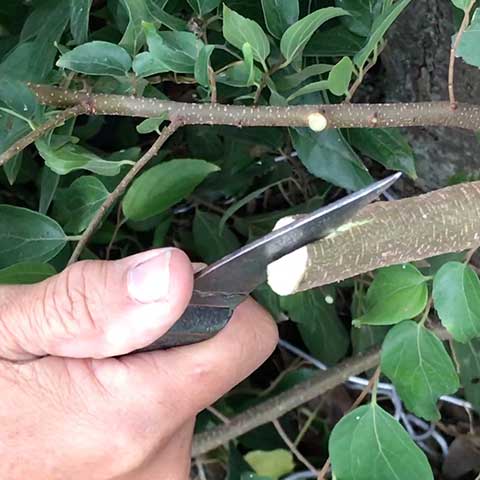Your Cart is Empty
spend R1000. 2kg or less. free shipping.
Menu

spend R1000. 2kg or less. free shipping.
bonsai
gardening
Orchids

Grafting Hackberry, method 2
3 min read
This post is part 2 of the 2 part series on grafting Hackberry. Read part 1 for the first type of graft.
The Taiwanese bonsai artist featured in this video clip is Master Chang Yong Zhou.
Method #2: Cleft Grafting
This grafting technique is very commonly used in grafting all manner of fruiting trees. In fact I am told that some Taiwanese bonsai practitioners come from a farming background and it is this background that they drew from and adopted the technique for developing bonsai.
I have not personally tried this method yet but plan to this spring as buds become active, as this is when this type of graft has the highest chance of success. The following factors will also contribute to the success of these grafts:
- Your trees must be growing strongly, most likely planted in a wooden box (learn how to build one here) or some oversize container as this species is a gross feeder and drinker. Better still this graft should be done while the tree is still being field grown.
- The graft should be done as trees are waking up from winter dormancy and sap flow is just beginning. You can confirm this as buds begin swelling. If they are open then you have missed your chance this season.
To perform the graft you will need the following tools:
- Sharp saw
- Sharp grafting knife
- Parafilm grafting tape
- Electrical insulation tape or Plastrip.
- Grafting sealer
Video
Method
- Decide where you want to graft.
- Identify the branch which you are going to use to graft with, which I will from now on refer to as the scion. It will need to be growth from the previous season, not older.
- Saw the branch and then split it slightly using the grafting knife and a mallet or a flat chisel.

- With this step completed you should now prepare your scion by cutting the branch and making the necessary cuts using your sharp grafting knife. The scion must be grafted in the same direction of sap flow so do not reverse this or the graft will not work.

- Wrap the scion with parafilm, which is breathable and perishable, leaving a piece at the end.

- Enlarge the split of the cut branch and insert the wrapped scion ensuring the cambium makes proper contact.

- Continue the parafilm wrap onto the branch and then finally wrap with either your electrical insulation tape or plastic to create a tight wrap.

- Seal any gaps or openings with grafting sealer to prevent moisture ingress or air.
- The the buds on the scion should develop if the graft was successful.
- After a month or so has passed the area will swell slightly and
- Begin reducing the sap flow to the scion by cutting the whip on the entry side of the graft, so the graft strengthens its sap flow to the trunk.
Success!
Final comments on method #2
If you have never performed a graft like this before then I would suggest practicing it a couple times to improve the chances of success before you try it on your {future} bonsai tree. You can use multiple scions on a single branch which will also increase the chances of success.
Selecting which method to use
Method 1
This method is ideal for placing branches onto a trunk or primary branch where you need them.
Method 2
When field growing sacrifice branches are used extensively to thick the trunk. Once these branches have performed their primary function rather than cutting them off at the base you can use a portion of them. Simply cutting them back, at the right time, will produce prolific back budding but it might not be where you need it. With this graft you can utilize the entire stub of the branch which you kept and at the same time the branch you graft will emerge at a convenient angle.
Reasons for Grafts Failing
These are the most common causes:- The cambium did not meet or insufficiently so is the #1 cause of failure.
- Timing was wrong. The cleft graft should be done in early spring and the approach graft in late spring.
- The scion or rootstock was not strong enough or healthy.
- The scion was inserted the wrong way round (reversed sap flow).
- The scions dried out during the operation or afterwards.
- The graft was not properly protected with grafting film.
- The scion was not properly secured, allowing movement.
Leave a comment
Comments will be approved before showing up.
Recent Articles
- Enthusiasts Top Wiring Tips July 17, 2023
- Top fertilizing tips March 28, 2023
- Top watering tips February 13, 2023
- Creating Japanese Maple forests October 24, 2022
- How to dig bonsai material August 15, 2022
- How I style bonsai and you can too April 30, 2022
- Swamp Cypress Bonsai Styling July 03, 2021
- How to hide large scars quickly June 14, 2021
- 14 Tips for Field Growing Bonsai May 31, 2021
- Aquaria: An Introduction January 06, 2021




